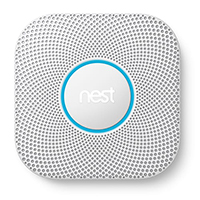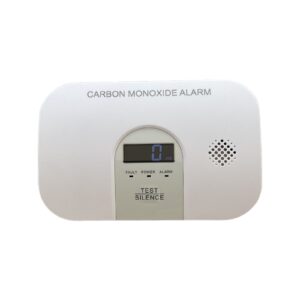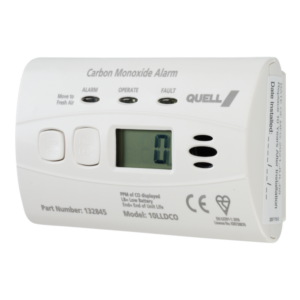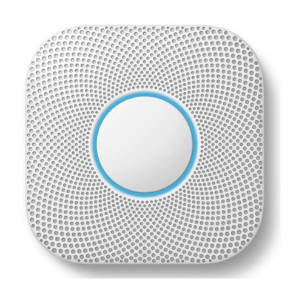From smart home to simple units, we found the best CO detectors to keep your home and family safe.
Best carbon monoxide (CO) detectors of 2024
SafeWise experts have years of firsthand experience testing the products we recommend. Learn how we test and review.
Nest Protect marries safety features like smoke, fire, and carbon monoxide detection with intuitive smart features. It's also a companion to your home security system and even a nightlight.
Nest Protect comes with an option for voice alerts to minimise panic. And it connects to the Google Nest app, so you'll get alerts from anywhere. Read on to compare this top carbon monoxide alarm to our other favourites.
Top 5 carbon monoxide detectors
- : Best overall
- : Budget pick
- : Easy installation

Riding out a particularly chilly spell? Stay safe and prevent carbon monoxide sickness with these tips:
- Make sure CO and smoke detectors have fresh batteries (or battery backup)
- Never use a generator or a gas/propane heater in the house, garage, or a shed
- Don't use the stove or a grill to heat the house
- Don't run a vehicle for warmth and/or power, especially in an enclosed area
Carbon monoxide detector reviews
1. Google Nest Protect: Best carbon monoxide detector
Nest Protect combines smoke and carbon monoxide detection and works with an app. When you download it, you can get alerts to your phone and even silence alarms if necessary. With state-of-the-art sensors for both fire and carbon monoxide, this alarm is one of the best for homeowners or renters.
Even though it's wired, it also comes with long-life backup batteries in case the power goes out.
The only downside to the Nest Protect is its comparatively high price.
For more information, read our full Nest Protect review.
2. Fire Pro Carbon Monoxide Detector: Budget pick
The Fire Pro carbon monoxide alarm is an affordable device with one job—to keep you and your family safe from CO poisoning. And while this cheap carbon monoxide detector doesn’t have any smart features, it does have a powerful 85 dB siren to warn everyone in your home.
It’s battery-powered, so you can stick it just about anywhere. Plus, it comes with a digital display for easy viewing of the current carbon monoxide level in your home.
And for just under $30, you can afford to add more than one to your home. Place one in the kitchen, garage, or anywhere you burn fossil fuels. You could even keep it in your vehicle.
3. Quell Worry-Free Carbon Monoxide Alarm: Best value
Price is accurate as of post date. Read full disclaimer.
Though the Google Nest Protect is our top pick overall, there's no going past the exceptional value on offer by the Quell Worry-Free Carbon Monoxide Alarm.
Like our budget pick above, this CO alarm is battery-powered, so it's portable and renter-friendly. But while other CO alarms are powered by AA batteries that need regular replacing, the Quell alarm comes with a 10-year lithium battery that won't require replacing at all in its lifetime.
Like other carbon monoxide detectors, it comes with a test button and digital display to show the CO level in your home. But it also has a unique feature that remembers the peak CO level measured since the last reset.
Final word
After hours of research and testing, we’ve found the best carbon monoxide detectors and smoke detector combos available. From basic battery-operated to smart carbon monoxide alarm devices, we think the Nest Protect is the best option for most people. We like its smart home features and the added safety of smoke detection to help keep you safe.
Carbon monoxide detectors FAQ
Check out our full carbon monoxide detector FAQ page to learn more about CO detection.
Carbon monoxide poisoning causes flu-like symptoms like dizziness, nausea, vomiting, headaches, confusion, or fainting.
If you're at home, get out of the house and call 000. CO poisoning doesn't always hit suddenly and doesn't leave your system quickly, so it's a good idea to seek medical attention as soon as you can.
Every year, over 250 Australians each year die from poisoning by carbon dioxide and similar gases.
Everyone is susceptible to carbon monoxide poisoning, but children, older adults, people who are physically ill, and pets are more likely to be affected by CO.
Carbon monoxide detectors work like smoke detectors but detect levels of carbon monoxide instead.
CO detectors usually have one or more of these sensors:
- Biomimetic detectors use colour-changing gels that absorb carbon monoxide which triggers the alarm.
- Metal oxide semiconductors have silica chips that detect CO and send electrical signals to trigger an alarm.
- Electrochemical sensors use electrodes in chemical solutions that sense changes in electrical currents when carbon monoxide is present, and they sound the alarm.
Put a home carbon monoxide detector outside every separate sleeping area in your home, your kitchen, and garage. We recommend finding an area far enough away from the carbon monoxide source but close enough to the areas you and your family normally occupy.
Types of carbon monoxide detectors
There are several types of carbon monoxide detectors available for purchase. Some include multiple functions:
- Dual-function: sense different threats like CO, smoke, fire, and gas
- Digital: show you levels of carbon monoxide on a digital screen
- Smart: run diagnostics and sync with home automation apps
- Hardwired: wire into your home’s electrical grid, work unless the power goes out
- Battery-operated: basic sensing and display, need batteries to operate
CO detector maintenance
Most carbon monoxide detectors last an average of five years. Although the product’s lifetime will vary depending on your make and model, you can still get the most out of your detector by wiping it down weekly to keep it clean from dust and debris.
Just like your smoke detectors, it's a good idea to test your CO detector monthly. Start by pressing the “test” button to ensure the siren works. If your detector is older, you can purchase a carbon monoxide meter to find out if your detector is still fully functional. If the carbon monoxide sensor doesn’t go off when you test it, it’s probably time to buy a new one.
Sources of carbon monoxide gas
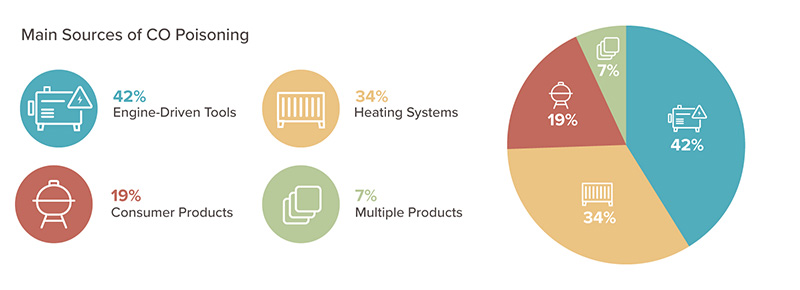
Image: SafeWise.com
Carbon monoxide (CO) has been called the “silent and invisible killer” because it doesn’t have a smell, colour, or taste. It’s one of the most prevalent causes of death due to poisoning by non-pharmaceutical substances in Australia. Any time you burn something—like gasoline, natural gas, wood, oil, propane, or charcoal—carbon monoxide is released into the air.
In outdoor spaces, this usually isn’t a health hazard because there is enough area for the CO to dissipate, so particles never amount to a toxic level. The danger comes when carbon monoxide is released in a contained area like your home, caravan, or garage.
Anything that burns will create carbon monoxide. It’s not just your stove, fireplace, or grill either. Here are some of the things that can create carbon monoxide when turned on:
- Appliances
- Gas barbecues
- Gas stoves
- Gas or oil-burning furnaces
- Fuel-burning water heaters
- Pressure washers
- Generators
- Non-electric cars, trucks, and boats
- Chain saws
- Non-electric space heaters
- Tools
- Lawnmowers
Know what to do and what not to do
Lighting a fire in your fireplace is okay if it’s properly ventilated. However, keep the following in mind or you could cause a dangerous level of carbon monoxide to build in your home:
How we reviewed
To find the best carbon monoxide detectors, we compared smart features, installation ease, and detection accuracy. We also looked at user reviews to get a better idea of how these devices work first hand. Visit our methodology page to learn more about how we conduct reviews like this one.
